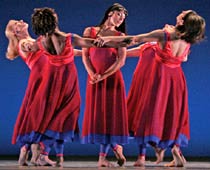Issue Archive
The Arts: A Shtetl in Hillbilly Heaven

An avant-garde clarinet player and a Southern-born dance icon pair up to create a playful performance in honor of the 350th anniversary of the American Jewish community.
Paul Taylor is watching members of his dance company rehearse. His eyes, peering over the tops of his glasses, match the faded blue denim of his work shirt. Finger to his chin, Taylor nods and occasionally leans down toward dancer Lisa Viola sitting at his feet, recording his corrections for the dancers in a stenographer’s notebook.
In this whitewashed studio above a noisy Soho street congested with delivery trucks and lunch-hour window-shoppers, rehearsals for the upcoming season of the Paul Taylor Dance Company are part of a familiar cycle of work and touring.
But this season is more high profile than usual. Paul Taylor, one of the country’s most eminent choreographers, is about to launch his 50th anniversary year. And one of its centerpieces is a new work celebrating the 350th anniversary of Jewish settlement in the United States.
Klezmerbluegrass brings together two unlikely collaborators: Paul Taylor, a self-declared “American mongrel,” a country kid who has never lost his bashful Southern schoolboy accent despite decades at the center of New York’s cultural life, and Margot Leverett, an avant-garde Jewish musician almost 30 years his junior, who in learning to bridge old-time country music and the riotous sound of klezmer discovered her own personal and professional identity.
This rehearsal marks the first time the two have met, but their work and their journeys converged in the studio’s animated space. Responding intuitively to the music’s side by side cultural strands, Taylor has imagined a moment when shtetl Jews recognized kindred spirits in their rural American neighbors. Or perhaps he has envisioned the ways Jewish immigrants, crowded into the urban tenements of the Lower East Side, dreamed of bucolic open spaces.
Taylor celebrates the American Jewish experience in a sequence of abstract vignettes that carry shifting moods but no overt narrative. With familiar, easy-to-read gestures, Klezmerbluegrass wraps upshtetl, hillbilly and American pop culture into a single charming package, identifying commonalities and exploring subtle variations.
Couples link elbows in gestures that belong equally to a Russiansher and an American square dance. They syncopate their heel-toe-heel steps with a whiff of the Charleston. The male ensemble—the men dance a stylized debka with arms over each others’ shoulders—refers back to line dances from every region of Eastern Europe and the Mediterranean. In another sequence the male dancers playfully chase the women through the crowd; in yet another, the men turn into human wheelbarrows. Longtime Taylor dancer Richard Chen See performs Cossack leaps with woozy, alcohol-inspired glee. The women act demure, dancing with folded hands and downcast eyes; at other times, open to invitations from the men, they are lofted away on their partners’ shoulders.
Taylor’s message is upbeat and sunny, and even when the music takes on a minor key it is short-lived. For example, in one solo, pouting, rageful Annmaria Mazzini slaps her thighs in a defiant gesture that says “Who cares?” to an invisible partner. Her melancholy and anger are shortlived. The rest of the community returns, skipping and buoyant, reabsorbing her into their midst.
Bright jewel-tone costumes designed by longtime Taylor collaborator Santo Loquasto reflect the vibrancy and cheer of the shifting dance and add a touch of Americana. Close-fitting costumes of peacock blue are covered by garnet-red netting, though the women’s costumes end in a graceful swirling skirt and the men sport blue-and-red ribbon accents on their shoulders and waists. “Paul wanted the costumes to be patriotic but not flag-waving,” says company general manager John Tomlinson. “One thing [Taylor and Loquasto] agreed on was that the costumes would not be doing any of the work of relating a story. It’s the music and the dance that carry the concepts.”
Taylor, who is not Jewish, notes that Klezmerbluegrass isn’t the result of any sort of formal ethnographic research. “I did not want to get too authentic…. I hadn’t wanted to specify a period,” he explains. In fact, the dance mixes in traces of Taylor’s own childhood memories. A duet for Julie Tice and Michael Trusnovec takes place in a barnyard—Trusnovec pantomimes milking a cow, just as Taylor did as a teenager during his stay on a 250-acre farm in Maryland. (Later, he’ll confide with a twinkle that one of his corrections to the dancer involved showing him where the cow’s udders would be—so as not to suggest he was milking a giant cow.)
The performance, which premiered last December in Illinois, has garnered positive reviews. “It’s an irresistible, folk-dance-flavored romp,” wrote The Seattle Times.
A light palate-cleanser, Klezmerbluegrass depends more on Taylor’s craft than his personal vision. Next to a demanding, intricate masterwork like his 1976 Cloven Kingdom, also on this season’s performance schedule, or last spring’s explosive Dante Variations, Klezmerbluegrass is not likely to find a place in the company’s permanent repertoire. Nonetheless, any new Paul Taylor work inspires celebration and, for this anniversary season, at least it will be seen by a broad range of audiences.
That national visibility was central to the vision of Richard Siegel, executive director of the National Foundation for Jewish Culture. He wanted the yearlong programming associated with “Celebrate 350: Jewish Life in America 1654-2004” to go well beyond the usual framework of lectures and exhibitions. “We decided to celebrate our anniversary not with a party but by adding something to the [dance] repertory,” he explains. “And access to the widest possible audience to see that work was more significant to us than the ethnicity of the creator.”
The NFJC could have commissioned new work from Jewish choreographers. In fact, a number of Jewish dancemakers, for example David Gordon (My Folks) and David Dorfman (Moving HIStories), had already used klezmer to explore and comment on the pleasures and tensions of their family heritage.
Siegel, however, had something else in mind. “We feel this anniversary… says something very different than was said 50 years ago or 100 years ago,” he says. Siegel was after a “synthesis of identities” that could play equally well in Jewish settings and venues far from centers of Jewish population. By cosponsoring the commission with arts organizations, local federations and individual philanthropists across the country, the NFJC hopes to articulate that Jewish culture is part of the American cultural experience.
Taylor responded to the commission by listening to many armsful of klezmer disks. At first, he says, “I couldn’t find anything—and what I did find was mostly gloomy.” Then Siegel’s friend, Leon Wieseltier, literary editor of The New Republic, sent Taylor a new CD from his own collection: Margot Leverett and the Klezmer Mountain Boys. “We had a date by the sea at Paul’s house on Long Island,” Weiseltier recalls, “and as soon as he listened to it, Taylor said ‘I think we might be out of the woods.’”
At the time neither Taylor nor Wieseltier realized that in searching for music that reflected both Yiddish and American folk traditions they had stumbled on a composer who herself came to klezmer as an outsider. Leverett was classically trained at the Indiana University School of Music. She became involved with avant-garde music when, in 1985, drummer David Licht heard her playing clarinet and introduced her to Frank London and Alicia Svigals, who were forming a new klezmer band. That band, the Klezmatics, went on to become one of the most influential of the klezmer revival. Later, she joined the all-women klezmer band, Mikveh, and in 2000, she released the well-received The Art of Klezmer Clarinet.
Throughout the two decades of her klezmer career Leverett was also exploring American fiddle music. More than once, she recalls, she’d sit down at an old-time “picking party” only to have traditionalists in the room walk out as soon as they saw her pull out a clarinet instead of a banjo. But some noted progressive bluegrass musicians, including Mike Marshall and Barry Mitterhoff, were open to experimentation. In 2001, she sat down with colleagues in her Brooklyn apartment and spread her stacks of klezmer music transcriptions on the dining-room table.
“Barry would play a bluegrass tune on the mandolin, and I would pick through the charts and find a klezmer tune that might go with it,” she remembers. “Some of them worked and some didn’t. The two kinds of music have a lot in common rhythmically. I first had the idea that…we’d do it for laughs, but when we got together to play, klezmer and bluegrass brought out the deep soul in each other.”
This juxtaposition of genres, however, was only part of the story. Twenty years of immersion in Jewish music had opened Leverett to a new sense of community and, as she says now, “revealed there was something in my life that I needed.” Six years ago, she converted. “At first I noticed I couldn’t get through the week without Shabbat. Well, I can light candles quietly at home and not tell people, so I did that for a while. Then, I felt I couldn’t get through the year without Passover. It was pretty easy to make a Seder myself or make sure I got invited to a Seder. Then I realized I could not get through the year without Yom Kippur. For that you have to be Jewish.”
That Taylor has choreographed a dance to her music is flattering, but it feels natural, too. After all, over the years she has played thousands of weddings, bar mitzvas and concerts where audiences routinely dance in the aisles. “I love when people dance,” she says. “It makes the music three-dimensional.”
Combining bluegrass and klezmer may seem counterintuitive, but audiences agree it works. “The easiest way to describe it,” says Leverett, “is that klezmer and bluegrass come from the same place in the heart. Both communities, I think, are rural people who have suffered but can still express their joy.”
Paul Taylor and Margot Leverett have distilled that joy in their complementary media. This season, their work will remind audiences throughout the country that, despite differences and difficulties, 350 years of mutual enrichment is a milestone all Americans can celebrate.
Debra Cash reviews dance and performing arts for public radio,Ballet Review and other publications. She was scholar-in-residence at the 2004 Jacob’s Pillow Dance Festival.










 Facebook
Facebook Instagram
Instagram Twitter
Twitter
Leave a Reply